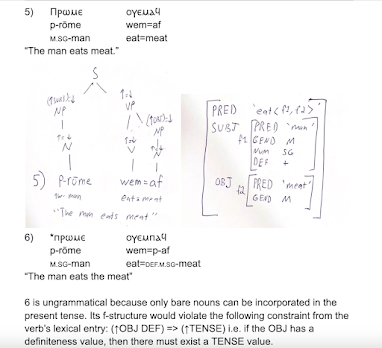Almost through my first year of linguistics grad school قربت نهاية أول سنة لي في برنامج الدكتوراه في اللغويات

I've been neglecting this blog for a while, but I thought I'd share some updates. Grad school has been keeping me pretty busy. In my first semester I took phonetics and syntax. In syntax we learned Lexical Functional Grammar (LFG), an interesting alternative to mainstream generativist syntax. For my final project I used LFG to try to analyze Coptic verb states. بقالي فترة بهمل البلوج دا بس قولت اشارككم بعض التطوراتت. الحياة في الجامعة مشغلاني كتير وفي التيرم الأول اخذت كورسين هما الأصواتيات (إن صح المصطلح) والنحو وفي كورس النحو تعلمنا ما يسمى (القواعد التوظيفية المعجمية) أي الLFG وهو بديل عجيب للنحو التوليدي الأكثر شعبية وللمشروع النهائي في كورس النحو حاولت تحليل أحوال الأفعال باللغة القبطي من خلال الLFG This semester I'm in phonology and semantics. Right now we're doing feature geometry and lambda calculus. It's my first time studying semantics since the short unit in my intro linguistics class in undergrad almost 10 years ago, and I'm struck by how much it
